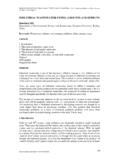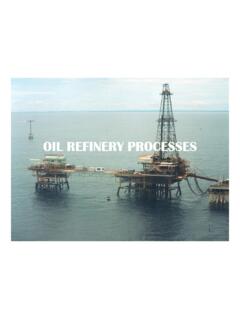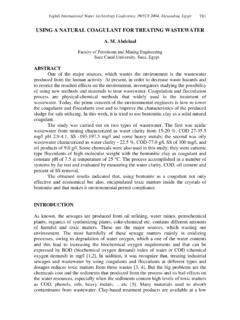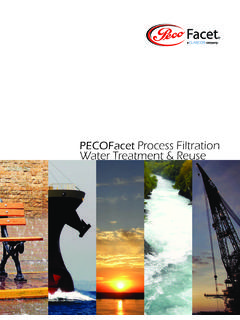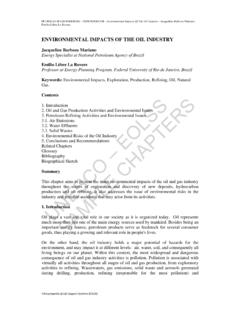Transcription of Petroleum refining water/wastewater management
1 Petroleum refining Operations Best Practice water / wastewater Series 2010. use and management The global oil and gas industry association for environmental and social issues 5th Floor, 209 215 Blackfriars Road, London SE1 8NL, United Kingdom Telephone: +44 (0)20 7633 2388 Facsimile: +44 (0)20 7633 2389. E-mail: Internet: IPIECA 2010 All rights reserved. No part of this publication may be reproduced, stored in a retrieval system, or transmitted in any form or by any means, electronic, mechanical, photocopying, recording or otherwise, without the prior consent of IPIECA. This publication is printed on paper manufactured from fibre obtained from sustainably grown softwood forests and bleached without any damage to the environment. Petroleum refining water / wastewater use and management IPIECA Operations Best Practice Series This document was prepared by AECOM, Inc. on behalf of the IPIECA Refinery water management Task Force.
2 The assistance of M. Venkatesh of ENSR AECOM is gratefully acknowledged. Cover photographs reproduced courtesy of the following (clockwise from top left): ExxonMobil; Nexen; Photodisc Inc.;. iStockphoto; Corbis; IPIECA. Contents Introduction 2 Effluent treatment 25. Process wastewater pretreatment 25. Refinery water overview 3. Desalter effluent treatment 25. Overall refinery water balance 3. wastewater segregation 27. Sources of water 3. Primary treatment 28. water leaving the refinery 4. First stage: separation Raw water treatment: 5 (oil/ water separators, API separators) 28. Use of raw water in refineries 5 Secondary oil/ water separation 29. wastewater 8 Equalization system 30. Location of the equalization system 31. Process water 8. Secondary treatment 31. Desalter effluent 8. Suspended growth processes 31. Sour water 11. Attached growth processes 35. Tank bottom draws 13. Spent caustic 14 Tertiary treatment 38.
3 Cooling water 16 Sand filtration 38. Activated carbon 38. Cooling tower blowdown best practices 18. Chemical oxidation 39. Condensate blowdown 18. Treatment of sludges 40. Boiler blowdown 18. API separator bottom sludge 40. Steam generator blowdown 18. DGF/IGF float and sludge 40. Unrecovered condensate 18. Waste biological sludge 41. Condensate blowdown best practices 20. Raw water treatment 20 Recycle and reuse issues 42. Raw water treatment best practices 20. Re-use of non-contaminated stormwater 43. Miscellaneous discharges best practices 20 Fire water 43. Miscellaneous discharges minimization 21 Cooling tower makeup water 43. Laboratory wastewater 21 Utility water 43. Spent/unused hydrocarbons samples Boiler feedwater makeup 43. best practices 21 Technologies for upgrade of refinery wastewater 43. Spent/unused wastewater samples . Basic media/sand filtration 44. best practices 21.
4 Microfiltration or ultrafiltration 45. Discharges from laboratory sinks . best practices 21 Microfiltration or ultrafiltration, with reverse osmosis 47. Discharges from bottle washing systems . best practices 21 Microfiltration or ultrafiltration, with nanofiltration 48. Stormwater and sewerage 22 Ion exchange 48. Technology summary refinery wastewater reuse 50. Stormwater segregation and management 22. Reuse of municipal wastewater 50. Contaminated stormwater 22. Non-contaminated stormwater 23 Media filtration 51. Microfiltration or ultrafiltration 51. Sewerage management 24. ii Petroleum refining water / wastewater USE AND management . Microfiltration or ultrafiltration, plus Figure 11 Typical refinery wastewater treatment 25. reverse osmosis 52. Figure 12 Desalter oil/ water separation 26. Microfiltration or ultrafiltration, plus nanofiltration 53 Figure 13 Desalter effluent stripper 26.
5 Ion exchange 53 Figure 14 Segregated wastewater treatment 27. Zero liquid discharge 53 Figure 15 API separator 28. Figure 16 Dissolved air flotation . References 55. a typical DAF unit 29. Figure 17 Induced air flotation (IAF) unit 30. Figure 18 Activated sludge system 32. List of Tables Figure 19 The PACT (Powdered Activated Carbon Treatment) system 33. Table 1 Typical sources of water 4. Figure 20 Sequencing batch reactor system 34. Table 2 Contaminants in raw water 7. Figure 21 Membrane bioreactor system 34. Table 3 Sources of wash water 9. Figure 22 Aerated lagoon system 35. Table 4 Desalter effluent contaminants 10. Figure 23 Trickling filters 36. Table 5 Sour water producers 12. Figure 24 Rotating biological contractor system 36. Table 6 Stripped sour water contaminants 12. Figure 25 Nitrification/denitrification system 37. Table 7 Crude tank bottom sediment and Figure 26 Sand filtration 38.
6 water contaminants 14. Figure 27 Activated carbon system 39. Table 8 Intermediate product stream . caustic treated 14 Figure 28 Chemical oxidation system 39. Table 9 Cooling tower blowdown contaminants 18 Figure 29 API sludge treatment system 40. Table 10 Contaminant specification for reuse water 42 Figure 30 DGF/IGF float treatment 41. Table 11 Refinery wastewater reuse summary 50 Figure 31 Biological sludge treatment 41. Figure 32 Contaminant removal for different types of filtration processes 44. Figure 33 Media filtration 45. List of Figures Figure 34 Microfiltration or ultrafiltration 46. Figure 1 Refinery water balance 3. Figure 35 Microfiltration or ultrafiltration, Figure 2 Typical desalter configuration 8 with reverse osmosis 47. Figure 3 Sour water stripper configuration 11 Figure 36 Microfiltration or ultrafiltration, Figure 4 Crude tank water draw 13 with nanofiltration 48.
7 Figure 5 Typical distillation system 16 Figure 37 Ion exchange treatment 49. Figure 6 Once-through cooling water system 17 Figure 38 Media filtration 51. Figure 7 Closed loop cooling system 18 Figure 39 Microfiltration/ultrafiltration 52. Figure 8 Evaporative cooling water system 19 Figure 40 Microfiltration/ultrafiltration, plus Figure 9 Boiler blowdown typical 19 reverse osmosis 52. Figure 10 Steam generator blowdown typical 19 Figure 41 Microfiltration/ultrafiltration, plus nanofiltration 53. Figure 42 Zero liquid discharge 53. 1. IPIECA. Introduction This manual describes typical best practices' and management in a refinery. Since each refinery is strategies used in Petroleum refineries to manage uniquely configured, some of these practices may or water , including ways to reduce water usage. may not be applicable based on the complexity of Improved water management in a Petroleum the refining operations, type of wastewater refinery can potentially reduce the volume and cost treatment operations available at a particular site, of raw water used in refinery operations.
8 Availability of raw water sources, discharge Furthermore, improved water management may configuration and type of receiving water body. This result in reductions in wastewater flow or manual will enable a refiner to compare their contaminant load or both. Lower flow and operations with typical industry practices and contaminant load may result in lower wastewater develop a plan for optimizing water management in treatment operating and maintenance costs. the refinery. Optimized water management may also reduce the mass of contaminants in the treated effluent, thus The manual is organized as follows: improving the quality of a wastewater discharge Introduction and ultimately the environmental impact of a Refinery water overview refinery's discharge. wastewater Stormwater and sewerage These practices are a collection of operational, Effluent treatment equipment and procedural actions related to water Recycle and reuse issues 2.
9 Petroleum refining water / wastewater USE AND management . Refinery water overview Petroleum refineries are complex systems of multiple tower evaporation and drift. A smaller amount of operations that depend on the type of crude refined water can also leave with the products. Certain and the desired products. For these reasons, no two processes require a continuous make-up of water to refineries are alike. Depending on the size, crude, the operation such as steam generating systems or products and complexity of operations, a Petroleum cooling water systems. Understanding water refinery can be a large consumer of water , relative balance for a refinery is a key step towards to other industries and users in a given region. optimizing water usage, recycle and reuse as well Within a refinery, the water network is as unique to as optimizing performance of water and wastewater the refinery as its processes.
10 This section describes treatment systems. the typical sources of water supplied to a refinery and the typical discharges of water from a refinery. Figure 1 shows a typical example of the water It also provides an overview of the types of balance in a refinery. contaminants contained in the raw water and the methods used to remove these contaminants. Sources of water Surface water water to the refinery can be supplied from various Overall refinery water balance surface- water sources such as rivers or lakes. In some cases it may also be supplied from the sea or from Many of the processes in a Petroleum refinery use other brackish water sources. Additional supply of water , however, not each process needs raw or water can come from groundwater located in treated water , and water can be cascaded or reused aquifers, if the subsurface water is available and in many places. A large portion of the water used accessible.

